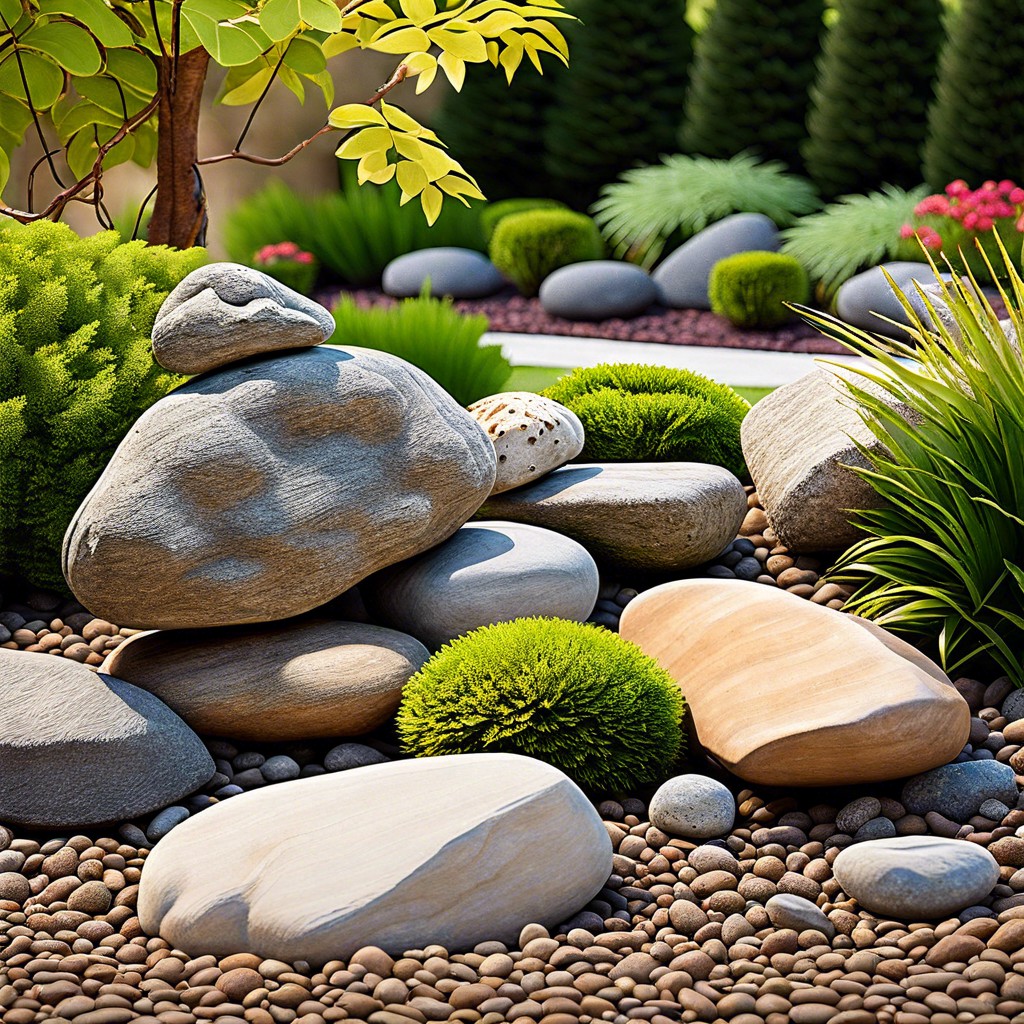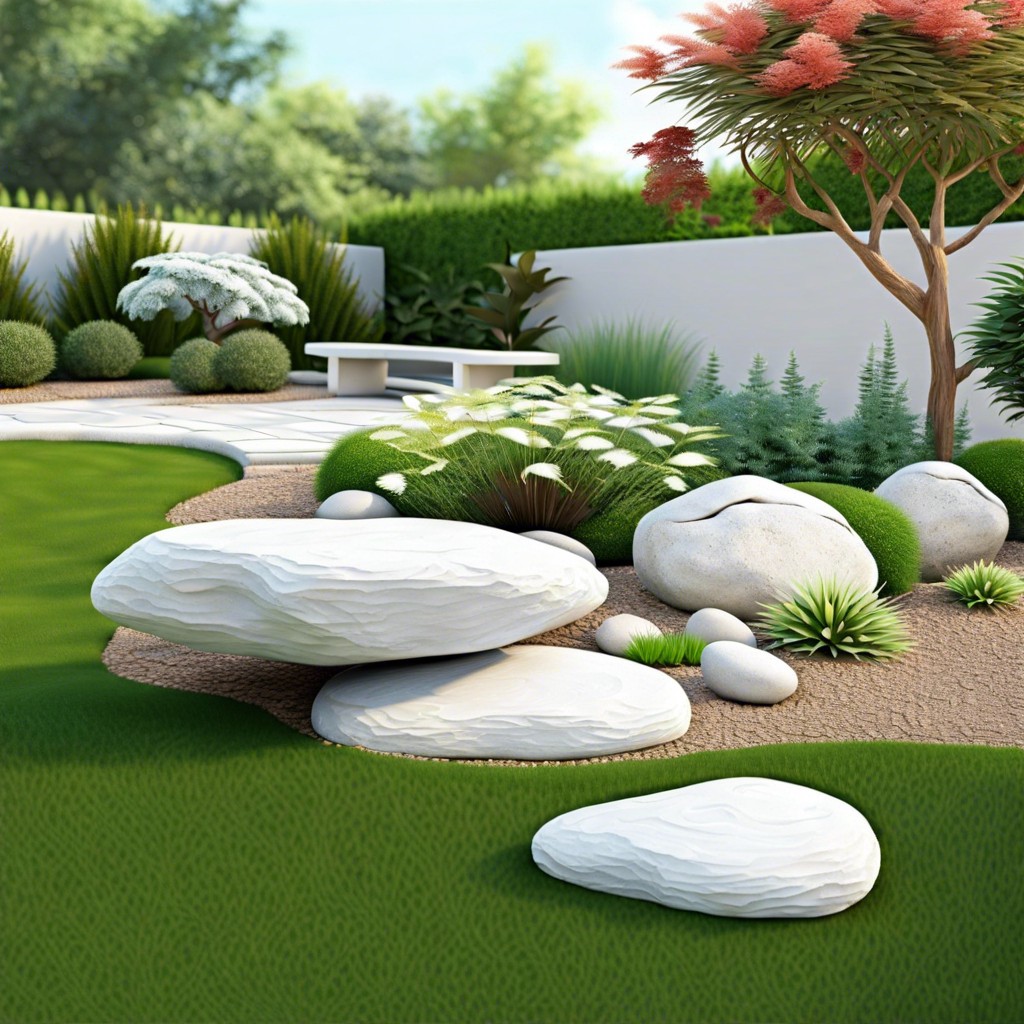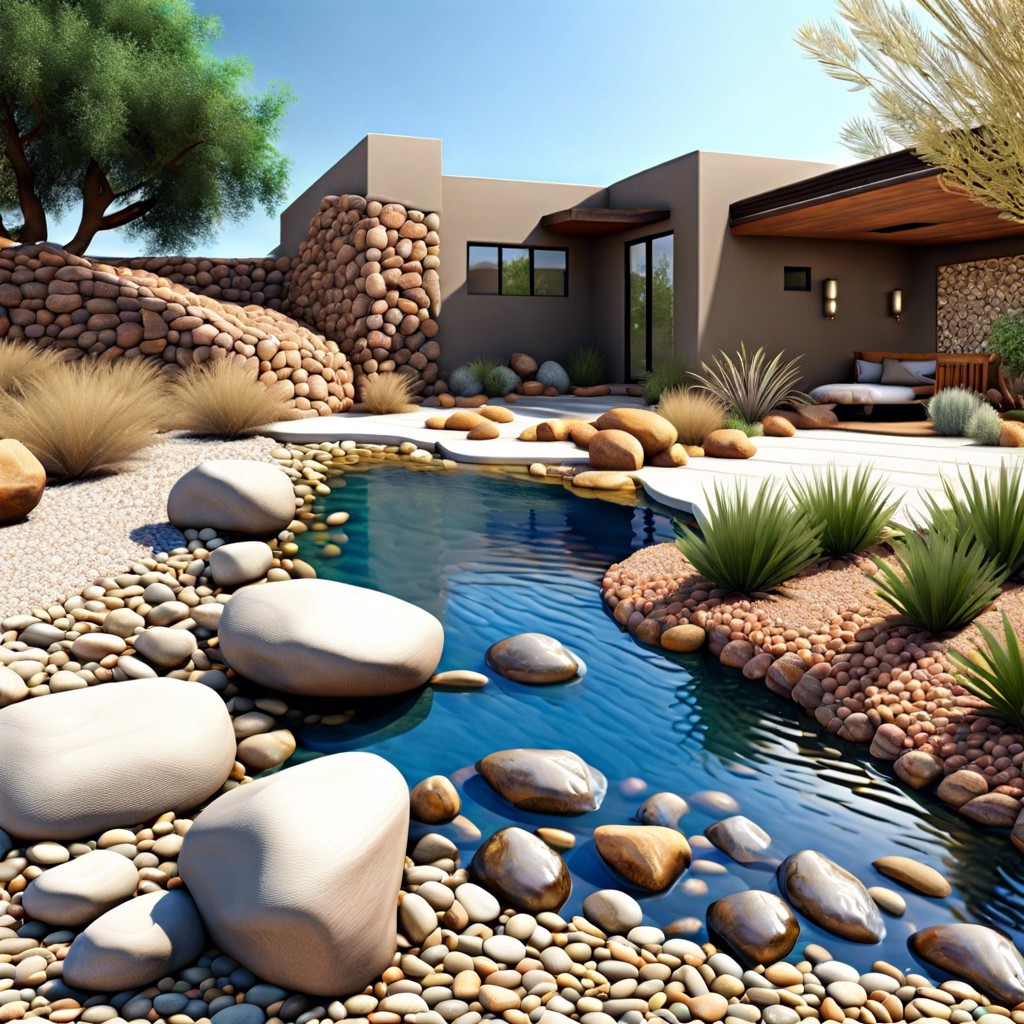Welcome to your practical guide on choosing large landscaping rocks to elevate your outdoor space with both beauty and function.
Key takeaways:
- Large landscaping rocks come in various types and styles.
- Using large rocks in landscaping provides erosion control and low maintenance.
- Consider color, shape, size, and texture when selecting rocks for your garden.
- Proper installation involves planning and leveling the rocks.
- The cost of large rocks can vary based on type, size, delivery, and installation.
Types of Large Landscaping Rocks

When it comes to jazzing up your outdoor space with some geological pizzazz, variety is indeed the spice of life. And by variety, I’m talking about the breadth of options in the large landscaping rock lineup.
First off, we’ve got boulders, nature’s own statement pieces. These hefty rocks turn heads and create natural focal points in your garden. Each one is like a snowflake—no two are identical—and they pack a visual punch when positioned smartly among greenery.
Next up, river rocks are the smoothened charmers of the rock family. They bring a sense of tranquility and a touch of the peaceful, babbling brook vibe to your yard. Their rounded edges and smooth surfaces are perfect for lining ponds or creating dry riverbeds.
For a slice of mountain majesty, consider using flagstones. These flat slabs are perfect for pathways, adding stability and rustic flair to your walks in the wild—or at least the wild appearance of your backyard.
And don’t overlook lava rocks with their rough texture and often dark, dramatic colors. These bad boys can make for an excellent contrast with the lush greenery, and their porous nature helps with soil drainage.
Lastly, for a more structured look, cut stone is the go-to. Regular shapes and sizes make them ideal for retaining walls or edging that requires uniformity and a touch of elegance.
Remember, each type of rock carries its own character and can completely shift the ambiance of your outdoor space, so think about the vibe you’re aiming to create before making your pick.
Benefits of Using Large Rocks in Landscaping
Imagine your garden not just as a patch of green but as a tapestry of textures, tones, and stability. Large landscaping rocks do just that—they create a visual anchor in the sea of soft foliage and blossoms. Now, let’s talk about adding these gentle giants to your green space.
First off, these hefty stones are champions at controlling erosion. With their weight and bulk, they stand guard against the onslaught of wind and water. They’re like tireless sentinels, keeping your soil where it should be. Plus, they demand zero pampering—no water, no pruning, just timeless, stoic beauty.
They also play the cool kids in the world of maintenance. Once settled in, they won’t bother you for anything. Big rocks have this ‘set it and forget it’ vibe. It’s like they’re telling you, “Go ahead, enjoy your weekend – we’ve got the yard.”
And talk about being friends with the environment! Opting for large rocks means minimizing the lawn area that needs regular mowing, not to mention the water you’ll save, which is quite a big deal during hot summers or in drought-prone regions.
Larger stones can add a natural touch to any landscaping tableau. They give off that “been here for centuries” look, even if you just rolled them in yesterday. They can also serve as natural seating — “nature’s benches,” we could call them — providing a spot to muse life’s wonders or simply to catch your breath after some gardening.
Lastly, when the night falls, they work their magic by absorbing heat during the day and then playing it cool by releasing it at night, ensuring the nearby flora get their warmth even when the sun clocks out. Just like that, large landscaping rocks become unsung heroes for your garden’s microclimate.
So, the seemingly mundane choice of a rock, quite literally, lays the groundwork for a dynamic and vivacious garden. Pretty solid benefits, wouldn’t you say?
How to Select the Right Large Rocks for Your Garden
When choosing large rocks for your garden, envision how they’ll blend with your greenery and blooms. Think about the color – will you go for a bold statement with stark white stones or opt for earthy tones that whisper rather than shout?
Shape matters, too. Smooth, rounded boulders bring a zen vibe, perfect for a serene oasis, while jagged, angular rocks can create a rugged, natural feel. Remember, it’s like picking furniture – you want the rocks to complement your garden’s style, not clash with it.
Size can be tricky—too small and they might get lost among your plants, too big and they might overpower them. Aim for a Goldilocks-esque balance. One substantial rock can serve as a focal point, or a grouping of medium-sized ones can guide the eye through your space.
Texture’s another consideration. Rough, porous surfaces work well in rustic settings, but if you’re crafting a sleek, modern nook, smooth might be the way to go.
Lastly, think local. Rocks from your region will likely be more affordable and eco-friendlier, given they don’t need to be hauled long distances. Plus, they’ll naturally fit the local landscape vibe – like they’ve always belonged there.
Installation Tips for Large Landscaping Rocks
Planting a giant boulder in your garden isn’t like popping seeds in the soil, right? This is a muscle-flexing, strategic affair. So, grab some gloves, and let’s get down to business.
First thing’s first: Mind your back! These colossal natural beauties weigh a ton, and we’re not all champion weight-lifters. Consider bringing in the cavalry—a landscaper with the muscle power of machinery to position your rock precisely where it should go.
Plan your rock’s final resting place like you’re mapping out buried treasure. Think about how it’ll affect drainage, and don’t let it crowd your petunias. Line the landing area with landscape fabric to discourage weeds from staging a takeover.
Now, you may fancy your rock leaning jauntily to one side, but it needs to nestle snugly into the soil to avoid any surprise rock ‘n’ roll. That means digging a shallow pit to help it settle cozily into the ground, like a bear into hibernation.
And remember, as tempting as it may be to eyeball it, a level is your best pal here. Ensuring your rock sits flat avoids any unwanted movement—it’s not going anywhere, come rain or high winds!
Last but certainly not least, give your new stony addition a decent drink with a hose to wash away any lingering dirt from the journey. Trust me, it’ll look like it’s always been part of the family.
Cost Considerations for Incorporating Large Rocks
Before jumping feet first into a rock-based transformation of your garden, it’s smart to weigh the financial implications. Large landscaping rocks, while striking, can also be quite the investment. Here’s the scoop on what might affect your budget:
The type of rock you fancy can swing the price needle significantly. Some rocks are like the diamonds of the dirt—they’re gonna cost you a pretty penny. Think along the lines of quartz and granite. On the flip side, local rocks, like limestone or sandstone, are often the budget-friendly compadres you may be looking for.
Size matters, and I mean that quite literally! The larger the rock, the deeper you’ll have to dig into those pockets. Not only do you pay for the bulk itself, but remember, big rocks aren’t going to just teleport to your garden—you’re looking at delivery fees that grow with the weight.
Then there’s the installation dance. If your back isn’t what it used to be or you just value walking upright, hiring professional help is a wise move. Labor costs can vary, but positioning a small boulder might not break the bank. However, once you’re looking at cranes lifting rocks that rival your car in size, the price tag becomes a bit heftier.
Lastly, don’t forget that getting these geological giants isn’t the endgame. You might also need to think about prepping the land or even creating a support base to keep these behemoths in place. Planning is key; get those ducks in a row to avoid any unexpected financial surprises.
Think of it as the fiscal fabric of your garden scene— it’s important to consider how the cost of these rocks will weave into the overall pattern of your landscaping expenses. After all, you want to enjoy your new rocky retreat without the weight of a strained wallet!




